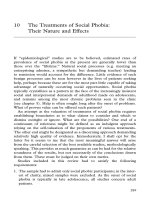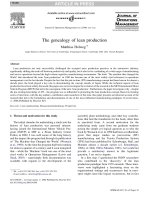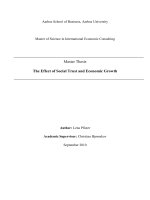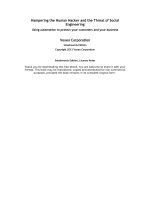The Genealogy of Social Phobia
Bạn đang xem bản rút gọn của tài liệu. Xem và tải ngay bản đầy đủ của tài liệu tại đây (73.17 KB, 9 trang )
2 The Genealogy of Social Phobia
If something can be said to exist formally and definitively only when it
acquires an official name, social phobia came into the world fully formed
with the publication of the DSM-III in 1980. The notion designated by
the name, however, is much older; the fearful self-protective pattern
itself is likely as old as humanity.
The dual purposes of this chapter are to trace the intellectual history
of the term, and to establish whether and how it has evolved. In carrying
out this overview I shall rely mostly on the invaluable historical survey of
Pelissolo & Le
´
pine (1995) concerning social phobia as such as well as
the broader overviews of the conceptual history of anxiety disorders by
Berrios (1999) and Glas (1996).
Before embarking on the historical survey, it is well to consider what
perspective regarding the nature of social phobia would serve our pur-
pose best. In principle, on a continuum of the nature of psychopathology,
two seemingly contradictory positions face off. On the one hand, social
phobia might be envisaged as a distinct entity occurring in nature and
obtaining universally that went unrecognized until discovered. On the
other hand, social phobia could be taken for a linguistic construction
denoting several ambiguous phenomena (lending themselves to numer-
ous readings) lumped together. This construction is a cultural product of
various social forces embedded in a particular way of life. On that view, as
the factors sustaining its use fluctuate, social phobia might fall into
disuse, could be replaced (e.g. ‘‘social anxiety disorder’’) so as to better
serve the purposes of those who advocate the change, or find its meaning
transformed with reversals in circumstances.
These two À admittedly extreme À perspectives would likely give rise to
quite different histories. I shall take an intermediate position, one that
attempts to reconcile the apparent contradictions. From the ‘‘naturalis-
tic’’ perspective one could argue that the core of social phobia is fear
(or anxiety, I use the terms interchangeably À see chapter 3) evoked by
interpersonal transactions and their social/cultural contexts. Fear, like
emotion in general, is a loosely linked cluster of responses incorporating
16
feelings, thoughts, behaviors and physiological activation, in this case
geared towards self-protection. Thus, fear is incorporated and visceral,
associated with a fairly well-defined physiological and endocrinological
pattern of responses coordinated by various systems in the brain involved
in emotional regulation (Misslin, 2003; Marks, 1987, pp. 177À227).
Furthermore, social phobia relates to one of four classes of common
(i.e. normal) fears reproduced in numerous surveys (Ohman, 2000,
p. 575). These are of: (1) interpersonal strife, criticism, rejection;
(2) death, disease, injuries, pain; (3) animals; (4) being alone and/or
trapped or amidst strangers far from a secure and familiar base. Social
phobia is obviously linked to the interpersonal cluster of fears, as the
fear-evoking situations triggering it are predominantly social.
From the ‘‘constructivist’’ perspective it could be said that the social
experiences, interpersonal behaviors and patterns of behavior generated
under the state of fear as well as the manner they are construed are
largely malleable, and as such indeterminate. Although tending to clus-
ter, they nonetheless vary among individuals, across cultures and social
practices.
Bearing these considerations in mind I shall proceed with the histor-
ical review.
Background
The term phobia derives from the Greek word phobos (attendant and son
of Ares À the god of war) denoting fear, terror, panic. Its source is the
worship of Phobos, who had the power to instill terror in enemies of
ancient Greeks. The deity was often depicted on weapons, especially
shields.
The term phobia only reappears in the literature in the mid-nineteenth
century, after an absence of 1,300 years. In the intervening period,
irrational fears combined with glum mood and much else went under
the heading of melancholia (black bile). For according to Hippocrates
‘‘temporary fears and terrors are due to overheating of the brain and
are associated with an expansion and preponderance of bile in that
structure’’ (Errera, 1962, p. 327).
In European culture before the eighteenth century, anxiety was mostly
linked to spiritual anguish, of interest to theologians and philosophers. A
common Christian belief for example was that such fear resulted from
sin. In this view timidity reflected an insufficient faith (in god) and
shyness expressed insufficient love (charity) for one’s neighbor.
With the secularization of life, the eighteenth century witnessed the
beginning of the medicalization of the abnormal experiences of fear.
The Genealogy of Social Phobia 17
Thus, medical treatises dedicated to the gut and the heart, for example,
described what today would be regarded as anxious complaints (e.g.
abdominal cramps, dry mouth, oppressive feeling in the chest:
Berrios, 1999, p. 84). Palpitations, for instance, were described as symp-
toms of heart disease and hyperventilation a disease of the lungs (1999,
p. 84). While the process of medicalization reached its peak in the first
half of the nineteenth century, a process of psychologization (e.g. Freud)
got under way in the second half. What in the former era were regarded
as symptoms of independent disease, in the latter period become facets
of putative entities (e.g. neurasthenia, anxiety-neurosis).
Launched in the USA and later adopted in Europe, neurasthenia was
conceived as a new disease category induced by ‘‘modern life.’’ As
defined, it involved fatigue and a vast range of depressive and anxious
manifestations. Anxiety-neurosis as proposed by Freud narrowed the
field to encompass an anxious state of distress combined with a ‘‘nervous
over-excitement’’ involving flushes, sweat, tremors, diarrhea, etc. Both
neurasthenia and anxiety-neurosis were considered by their proponents
diseases of the nervous system, the putative sexual etiology of the latter
notwithstanding. The continued failure however to find any neurological
or other cause accounting for ‘‘nervous disorders’’ during the nineteenth
century, cleared the way for psychological theories.
The Notion of Social Phobia
The term ‘‘social phobia’’ originated with Janet (1903). While the label
is roughly 100 years old, the pattern of behavior it denotes has been
noticed and described since antiquity. Burton (1621, quoted in Marks,
1987, p. 362) for example set forth a state of fear that ‘‘amazeth many
men that are to speak, or show themselves in public assemblies, or
before some great personages, as Tully confessed of himself, that he
trembled still at the beginning of his speech; and Demosthenes that
great orator of Greece, before Phillipus.’’ Burton gave further the exam-
ple of Hippocrates who ‘‘through bashfulness, suspicion, and timor-
ousness, will not be seen abroad; loves darkness as life, and cannot
endure the light, or to sit in lightsome places; his hat still in his eyes,
he will neither see nor be seen by his good will. He dare not come in
company, for fear he should be misused, disgraced, overshoot himself
in gestures or speeches or be sick; he thinks every man observes him’’
(1987, p. 362).
Systematic and mostly medical interest in the phenomena clustered
around the construct of social phobia crystallized late in nineteenth-
century France. There were several strands to this trend.
18 What is Social Phobia?
First, it was construed as a phobia. Within the context of a classifi-
catory scheme Janet (1903) conceived of four types of phobias:
situational, bodily, of objects, and of ideas. Situational phobias were
further subdivided into those related to places (open À agoraphobia;
enclosed À claustrophobia) and those related to social occasions. Janet
emphasized repeatedly the social nature of the phobic fear. This arises
only in response to having to act in public or interact with someone, for
such individuals do not fear shaking or blushing when alone, for
instance. Janet proposed the term social phobia or phobia of society to
stress this point. He conceived social phobia broadly as ranging over fear
of blushing, of intimacy (and sex), public speaking and acting from a
position of authority, among others.
Second, several detailed descriptions of cases of ereutophobia (blushing
phobia) and discussions of related conceptual issues were published.
Notable is a Swiss psychologist, Claparede’s (1902), contribution.
Although narrowly conceived as concerning only blushing, the social
and the phobic aspects were emphasized. Neither was necessarily recog-
nized as such by all authorities; some construed the morbid dread of
blushing as an obsession; others of a more traditional medical bent,
a cardiovascular problem.
Attempts at treatment are mentioned: alcohol, and opium among
others, but also hypnosis and psychotherapy. In a refractory case,
leeches were applied, followed by a sham operation designed to simulate
a ligature of the carotid arteries. Improvement was short-lived.
Thirdly, Dugas (1898), and especially Hartenberg (first published in
1901; I have used the available 4th edition of 1921) approached the
crippling fears of the social phobic pattern of behavior as an exacerbation
of a common dimension of personality À namely shyness (‘‘social anxi-
ety’’ in modern parlance) À rather than as a putative abnormal entity, as
did Janet and Claparede. Philosophically, Hartenberg considered himself
a positivist psychologist ‘‘more interested in behavior than in the soul’’
and believed in ‘‘the predominance of the affective life and in the
JamesÀLange theory of emotions’’ (Berios, 1999, p. 90). Both Dugas
and Hartenberg trained under Ribot and with him ‘‘believed that both in
psychiatry and in education the emotions were more important than the
intellect’’ (1999, p. 91).
Hartenberg (1921) emphasized the situational nature of social anxiety.
Furthermore, he conceived of social anxiety as an admixture of two basic
emotions: fear and shame. He related primarily the somatic experi-
ences (e.g. palpitations, tremor, sweating), but also the experience of
dread À to fear. Self-consciousness, a heightened sense of propriety
and blushing were expressions of shame. Social anxiety is evoked socially
The Genealogy of Social Phobia 19
by engaging with others and thereby submitting to their scrutiny. It is
generated through the dread of falling short of expectations or of appear-
ing inferior or ridiculous.
Hartenberg (1921, pp. 21À40) gave a most comprehensive and
detailed description of a paroxysm of social anxiety (acces de timidite).
This involves, among others: (1) cardiovascular reactions (e.g. palpita-
tions and due to peripheral vaso-constriction, cool extremities, and
pallor); (2) respiratory difficulties; (3) gastro-intestinal and bladder
muscle malfunctioning giving rise to vomiting, cramps, and alternating
diarrhea and constipation and the urge to urinate; (4) muscle tension in
the face, trembling and incoordination of the hands; (5) speech difficul-
ties due to troubled breathing and incoordination of muscles involved
in articulation; and (6) mentally: blunted perceptiveness, diminished
responsiveness (e.g. ability to concentrate), and confusion. An indirect
testimony to the social nature of such anxiety is the almost universal
tendency to dissimulate its manifestations (1921, p. 83).
Hartenberg’s (1921, pp. 157À182) dimensional conception of social
anxiety is in evidence in his singling out several occupations whose
practitioners are at risk of what might be termed stage fright or perfor-
mance anxiety (‘‘le trac’’). Namely, these are stage actors, musicians,
lecturers, preachers and trial lawyers. Were they not bound to perform
in front of an attentive (and possibly critical) audience, there would be
no fear. To Hartenberg (1921, pp. 183À184), common social anxiety
becomes morbid when it is exaggerated, becomes over-generalized and
chronic. Anxiety however is embedded in a personality constellation
characterizing the shy. Interpersonally, these tend to sensitivity, propri-
ety, dissembling, passivity, isolation, pessimism, and suppressed resent-
ment among others (1921, pp. 47À100).
As a man of his time, Hartenberg (1921, p. 217) was unequivocal
about the main cause of morbid social anxiety: predisposing inherited
constitutional defects. His analysis of causality however also included
determinant causes (e.g. physical, psychological) or social defects (real or
imagined) as well as occasional (i.e. situational) causes. As to the latter,
he commends English education for its emphasis on physical exercise
and the encouragement of freedom and initiative as the key to its success
in producing the least shy individuals.
His approach to treatment was reassurance and a behavioral therapy.
In today’s terminology this would include exposure in vivo, role-
rehearsal for public speaking and modification of posture and other
non-verbal elements of social behavior. For fear of reading in public,
for example, he recommended graduated exercises of reading in the
classroom. First it was to be done in unison with the whole class,
20 What is Social Phobia?









